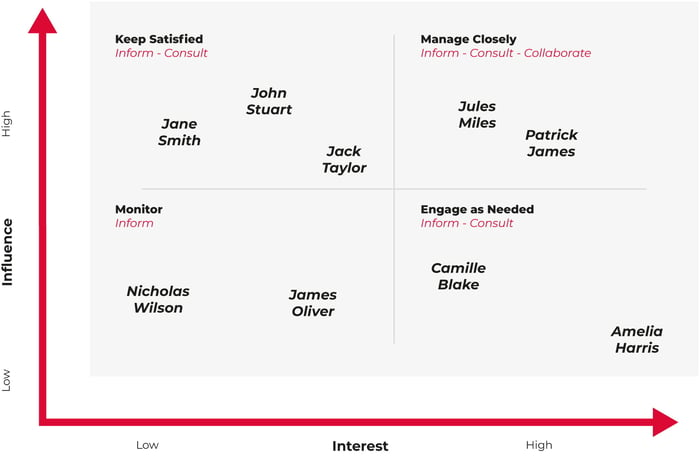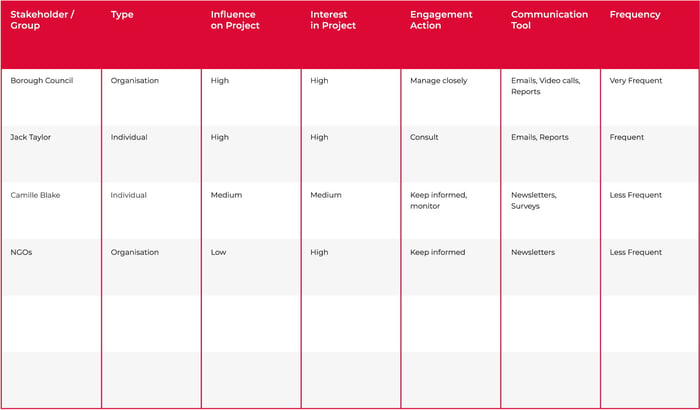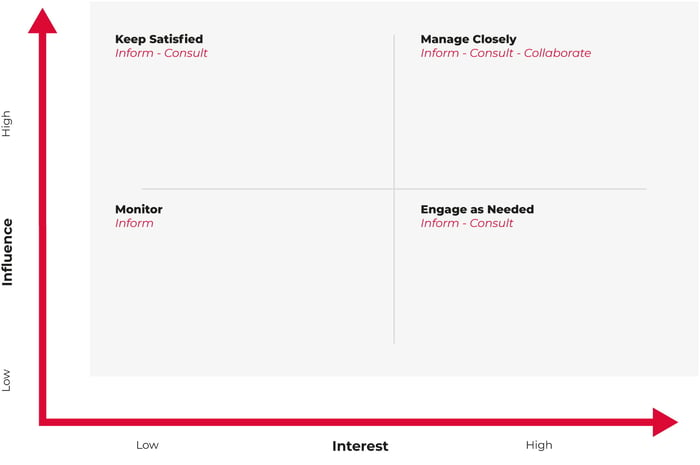When planning a stakeholder engagement strategy, knowing exactly when and who you need to engage with is crucial to help you get stakeholder buy-in.
Stakeholder mapping is one of the best ways to learn about your stakeholders to support effective communications.
This article covers everything you need to know about stakeholder mapping so you can start creating your own.
Scroll down to keep reading, or download the Stakeholder Mapping Guide (with templates) here:
- What is stakeholder mapping?
- Why is stakeholder mapping important?
- Stakeholder mapping benefits
- How to do stakeholder mapping?
- Considerations
- Stakeholder mapping tools
What is stakeholder mapping?
Stakeholder mapping is a visual representation, usually in the format of a four-quadrant matrix, of the various people that are interested in or are affected by your project (or product, service).
The stakeholder map visually represents a stakeholder analysis and provides a clear picture of your different stakeholder groups, how they are connected and their relevance to your project. It can include a person, several people or organisations, as well as internal and external stakeholders.
Here’s an example of a stakeholder map:
.png?width=550&name=MicrosoftTeams-image%20(7).png)
In this example, the stakeholders are being analysed according to their levels of interest (how much they are impacted by or want to be involved in your project) and influence or power (how much they can impact the project).
Stakeholder maps can be created using a set of criteria (attributes) that are relevant to your stakeholder analysis. The most common criteria used are interest and influence, but can also be used to assess expertise, relationship, attitude, sentiment, relevance, reputation, sustainability and more.
Based on what’s important for your project, you can choose the criteria you wish to track and analyse in your stakeholder mapping.
Why is stakeholder mapping important?
Stakeholders can be the difference between a project’s success or failure. Therefore, understanding and managing their expectations regarding your project is essential to support positive outcomes.
Stakeholder mapping is the first step to creating an effective communication plan that will help you keep your stakeholders engaged.
Without learning the levels of interest and power they have on your project, you won’t be able to determine how much information they must be given, how frequently they should be contacted or through which channels.
Whether you’re launching a new product or service or looking to improve your project management, stakeholder mapping is an important process to help you acknowledge your stakeholders’ relationship to your organisation.
The stakeholder mapping benefits
Building a stakeholder map will enable you to:
- Categorise your stakeholders (and understand their needs)
With a stakeholder map, you can identify the various stakeholder types and group them according to their level of importance for your project. It also allows you to identify the key stakeholders of your project so you can engage with them from the very start.
- Determine the best communication methods
By knowing how many stakeholders you must engage with and the level of information they require, you will be able to select the appropriate communication channels to keep them happily informed and engaged.
- Allocate time and effort more efficiently
Learning who and how you will engage with your stakeholder groups will prevent you from wasting time and effort, as you will be able to properly allocate time between those who require more dedicated attention and those who need less frequent communication.
- Obtain valuable insights
Good communications with your stakeholders will result in gathering valuable feedback from them. They can provide important insights and help fill in project gaps, especially those who have a high level of expertise related to your project.
- Mitigate risks
Considering your key stakeholders’ perspectives can help you uncover potential risks and take action, allocating resources to prevent them from happening and keeping your project on track.
How to do stakeholder mapping
Here are the steps on how to create a stakeholder map and get you started with your stakeholder mapping process:
1. Identify your stakeholders
Based on the project and its objectives, start by creating a list of all its potential stakeholders, from people and groups to organisations. Consider everyone that may be affected by or can have an influence or interest in your project and its outcomes.
Do not remove or disregard anyone just yet. The more granular you are, the better to ensure you have considered all relevant stakeholders. As your project evolves, you may need to update your list, adding or removing stakeholders.
2. Analyse and categorise
Once you have your list ready, you will analyse your stakeholders to identify types so you can group them into categories.
You can group them by how much they can influence the project for example, how much involvement they have in it or their level of engagement.
Categorising your stakeholders will help you later view who are your key stakeholders in your stakeholder map.
3. Map your stakeholders
This is where the proper mapping happens.
Using a simple four-quadrant matrix, select the attributes you want to analyse and start plotting your stakeholders according to the axes.
Here's a stakeholder mapping example, using the influence and interest attributes:

As mentioned in step number 2, this visual map will help you identify your most influential stakeholders, as well as the ones who have less impact or influence.
4. Plan your communications
With your stakeholder properly mapped, you now have detailed information to design a communications plan that considers the different levels of engagement for each group.
According to their position on your map, you will know who must be managed closely and who just needs to be monitored.
Here's an example of a stakeholder engagement matrix used to plan communications:

This way you're able to plan the right number and type of communications, providing more detailed and deeper engagement for key stakeholders while delivering a more general engagement to stakeholders that have lower levels of interest and influence.
Stakeholder mapping considerations
Stakeholder mapping is a great technique to grasp the relationship between your project and its stakeholders. And just like in any relationship, there can be positive or negative changes.
That’s why it’s important to keep track of your stakeholders and their views by reviewing your mapping. The frequency you should review it will depend on your project’s objectives, phases, and duration. You may determine it’s best to do it every 3 months, 6 months or even a year.
Conducting these reviews will provide you with helpful insights into how clearly you are engaging with your stakeholders and how satisfied they are with how (and when) you communicate with them.
This is valuable information you can use to further refine your communications and ensure you meet your stakeholders’ expectations.
Stakeholder mapping tools
There are many stakeholder map tools available online in different formats, from Word and Excel files to pdf templates.
Here's a stakeholder mapping chart you can download below to use:

Download now the stakeholder mapping guide with templates.
Consider how much time and resources you have to dedicate to your stakeholder mapping process.
If you’re managing a large project with many stakeholders, manually analysing and mapping each one of them will take a considerable amount of time when using spreadsheets or other similar types of tools.
Using a proper stakeholder mapping tool, such as software, can save you hours of time and effort.
With a stakeholder mapping feature like Tractivity’s stakeholder mapping module, you can easily add all the attributes you wish to monitor, assign scores to your stakeholders against these attributes and analyse them in a chart with the click of a button, with no need to manually plot each one of them.
In addition, it allows to you add multiple phases to keep track of your stakeholders’ evolution and create distribution lists based on their scores and reports.
Support the success of your projects with stakeholder mapping
Dedicating time to work on stakeholder mapping and analysis is an essential step to avoiding obstacles and issues with your project further down the road.
Successful projects rely on effective stakeholder management and collaboration, and the stakeholder map process plays a key role in supporting better communications and engagement.
Tractivity is the leading stakeholder engagement system in the UK and is helping many small and large organisations effectively engage with stakeholders and deliver better outcomes. Learn more about how we can streamline stakeholder mapping and engagement for you, book a free demo with us today.



